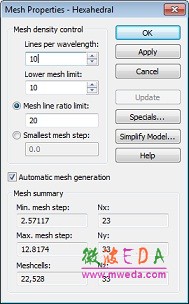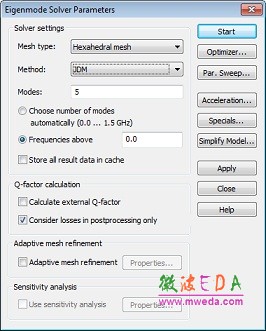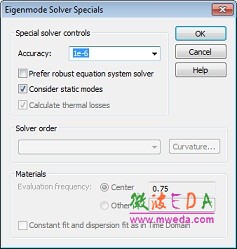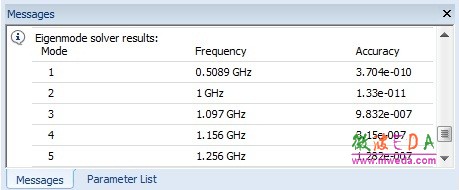CST谐振腔体设计分析—CST2013设计实例
Eigenmode Calculation with JDM
CST MICROWAVE STUDIO offers the possibility to choose the JDM eigenmode solver. This solver is recommended only if a small number of eigenmodes are required (5 modes or less). Since this is a tutorial, it is convenient to reset the mesh settings to the initial values of the mesh adaptation to speed up the calculation. Open the Mesh Properties dialog for the hexahedral mesh by selecting Home: Mesh Global Properties : and set both Lines per wavelength and Lower mesh limit equal to 10.

There may be old results present from the previous solver run that will be overwritten when changing the mesh. In this case, the following warning message appears:

Press OK to acknowledge deletion of the previous results.
The solvers parameters are specified in the solver control dialog box that can be opened again by selecting Home: Simulation Start Simulation . Select from the Method drop down menu the eigenmode solver JDM and reduce the number of Modes to 5. With these settings the solver will calculate 5 modes starting from the lowest resonance frequency.

Before starting the eigenmode solver, you may select the Specials button in order to change the desired accuracy for the eigenmodes. In this case, the value of 1e-6 is sufficient and you can leave the box unchanged by pressing the OK button.

Finally, press the Start button. A few progress bars will appear in the status bar again, keeping you informed of the current status of your calculation (e.g. matrix calculation, eigenmode analysis). After the solver has finished, the resonance frequencies of the first five modes are displayed in the main view.

In order to review the solver time required to achieve these results, you can display the solver log-file by selecting Results > View Logfiles > Solver Logfile from the main menu. Please scroll down the text to obtain the timing information . The solver time required for the calculation is comparable to the AKS eigenmode solver.
Please note: In contrast to the AKS eigenmode solver, the JDM requires no guess of the highest eigenfrequency and the eigenmodes are calculated to a prescribed accuracy. The visualization of modes, Q-factor calculation and mesh adaptation are carried out as for the AKS eigenmode solver.
In contrast to AKS, the JDM does not currently support TST mesh cells. Furthermore, the AKS solver should be used if many modes have to be calculated. The JDM eigenmode solver is able to calculate eigenmodes of lossy structures (const. complex permittivity). However, if you require the Q-factors and the losses are small, it is advisable to calculate the eigenmodes of the loss-free structure first. This is done by default, see the < i>Consider losses in postprocessing only check box. Afterwards, you can compute the Q-factors by the post-processing step described previously.
-

CST中文视频教程,资深专家讲解,视频操作演示,从基础讲起,循序渐进,并结合最新工程案例,帮您快速学习掌握CST的设计应用...【详细介绍】
推荐课程
-
7套中文视频教程,2本教材,样样经典
-
国内最权威、经典的ADS培训教程套装
-
最全面的微波射频仿真设计培训合集
-
首套Ansoft Designer中文培训教材
-
矢网,频谱仪,信号源...,样样精通
-
与业界连接紧密的课程,学以致用...
-
业界大牛Les Besser的培训课程...
-
Allegro,PADS,PCB设计,其实很简单..
-
Hyperlynx,SIwave,助你解决SI问题
-
现场讲授,实时交流,工作学习两不误






